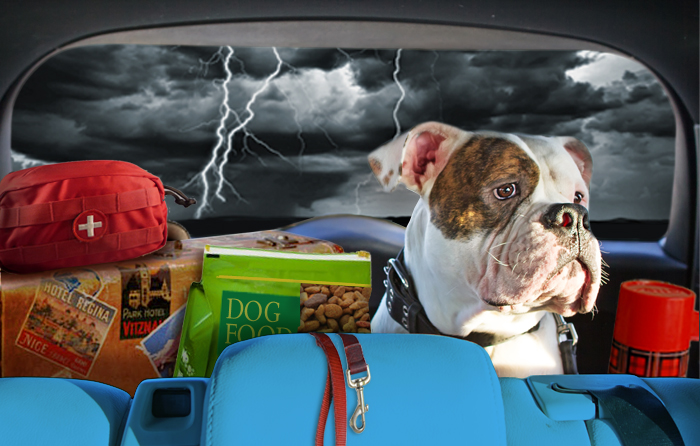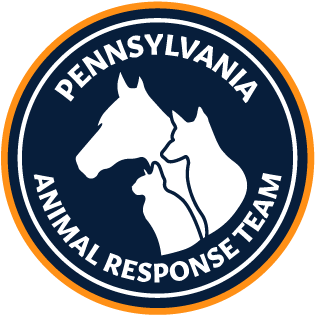For Pet Owners
Animal emergencies create danger for animals and their owners.
Lack of preparation leads to unnecessary tragedy, human injury, and economic loss. Pets are the Number One reason people return to their homes before local authorities have declared it safe to do so, risking lives in the effort to save beloved pets. Pennsylvania is home to millions of agricultural and domestic animals. SART encourages all pet owners to evacuate with their animals to prevent endangering human and animal lives. By remembering to include your pets as part of your family’s emergency evacuation plan, you can avoid those last minute decisions that could endanger the safety of your family and pets.
Sound animal disaster preparedness planning should encompass:
- One week’s emergency rations and water
- Identification tags, leg bands or tattoos
- Pet first aid kits
- Current photos of your animals filed with your important papers
Winter Preparedness for Dogs and Cats
Beware of cold temperatures. While many pets can be safe in outside temperatures with proper shelter (see below), puppies, smaller dogs, older dogs and cats should not be left outdoors when the temperature falls below 40 degrees.
Watch for signs of frostbite and injury. Dogs’ ears, paws and tails are especially susceptible to frostbite. If you suspect frostbite, contact your veterinarian. If your dog plays on ice or hard, frozen dirt, his paws are susceptible to cuts as his paws slide across these rough surfaces. Always wipe your dog’s feet after a walk in the snow to remove ice balls and salt deposits from the road. Salt irritates a dog’s paws and can be toxic if ingested. Use only pet-safe ice melt.
Keep an eye out for hypothermia. If you notice shivering, lethargy, low heart rate and unresponsiveness, bring your pet into a warm area, place a light blanket over him, and call your veterinarian.
Eliminate the possibility of poisoning. Unfortunately, dogs like the sweet taste of antifreeze, which can cause sickness or even death if ingested. Make certain that all antifreeze containers are well out of reach of dogs and thoroughly clean any spills immediately.
Keep older, arthritic pets inside. These animals should not be left outside under any circumstances. Escort the older dog outside for toileting and use a leash if the yard has ice or snow. Older dogs can easily fall and seriously injure themselves.
Provide a protective shelter. If your dog or cat stays outside much of the time in the winter, his shelter needs to be raised a couple of inches off the frozen ground or concrete. The inside needs to have a blanket, cedar shavings or straw, which should be changed frequently to keep him warm and dry. Add a flap to the door, and face the shelter away from the weather. The size of the shelter should be large enough so your pet can sit and stand, but small enough so his body heat will be retained in the house. Use a plastic water bowl to ensure your pet’s tongue does not get stuck to cold metal, and change the water often to keep it from freezing.
Supply fresh water. Use a plastic water bowl to ensure the dog’s tongue does not get stuck to cold metal, and change the water often to keep it from freezing.
Provide an appropriate amount of food. If your dog remains active in winter, he’ll burn more calories in the cold—and needs about 10 percent more food to compensate. If your dog becomes less active in the winter, try to keep him from gaining extra weight by cutting back his food and making sure you continue going for walks and playing with him.
Keep your dog on a leash. Dogs rely heavily on a strong sense of smell to figure out where they are and can easily get lost during winter storms. Snow covering the ground will make their surroundings less familiar. Keeping your dog on a leash at all times – especially during winter storms – can help stop your dog from becoming lost. Also talk to your veterinarian about microchipping your dog, just in case.
Don’t leave your dog inside of a parked car. Most people know this rule for the summer. A parked car can quickly amplify the effects of extreme weather. During the winter it can act as an icebox and trap cold air inside.

For Horse Owners
Animal emergencies create danger for animals and their owners. Lack of preparation often leads to unnecessary tragedy, human injury, and economic loss. Pennsylvania is home to millions of agricultural and domestic animals. PART encourages all horse owners to evacuate with their animals to prevent endangering human and animal lives. If evacuation is not possible, developing alternative plans to provide for the safety of your horses need to be developed and put in writing. By remembering to include your horses as part of your family’s emergency evacuation plan, you can avoid those last minute decisions that could endanger the safety of your family and horses.
Emergency Planning Workbook (Courtesy of EquineU.com)
theHorse.com Special Reports (Free articles on many aspects of horse health care)

For Farmers
We usually get a little bit of warning before a natural disaster strikes. Most likely, every time you turn on the television before a storm there will be a storm warning blinking at the bottom of the screen. No one knows what will happen during the storm, but everyone can be prepared for the after affects. Farmers should be prepared for downed trees, electricity outages, flooding, shelter damage, or contaminated water sources. Planning and preparation for these events can limit your damage and losses.
Large animals, such as cattle, horses, sheep and goats, also need help
with winter weather. Cattle stay warm by increasing their heart rate, respiration and blood flow. This is why livestock need to increase their feed intake during the winter months. Keeping outdoor animals dry and warm is key. If fur is wet and matted, it loses its insulating qualities. Shelter should be windproof and insulated. Providing bedding of straw, hay or blankets will
provide extra warmth.
Click on the links below to find some information on how to stay one step ahead of the game:
NFPA Barn Safety Checklist
PASART Emergency Preparedness Guidelines for Livestock July 2012.pdf

